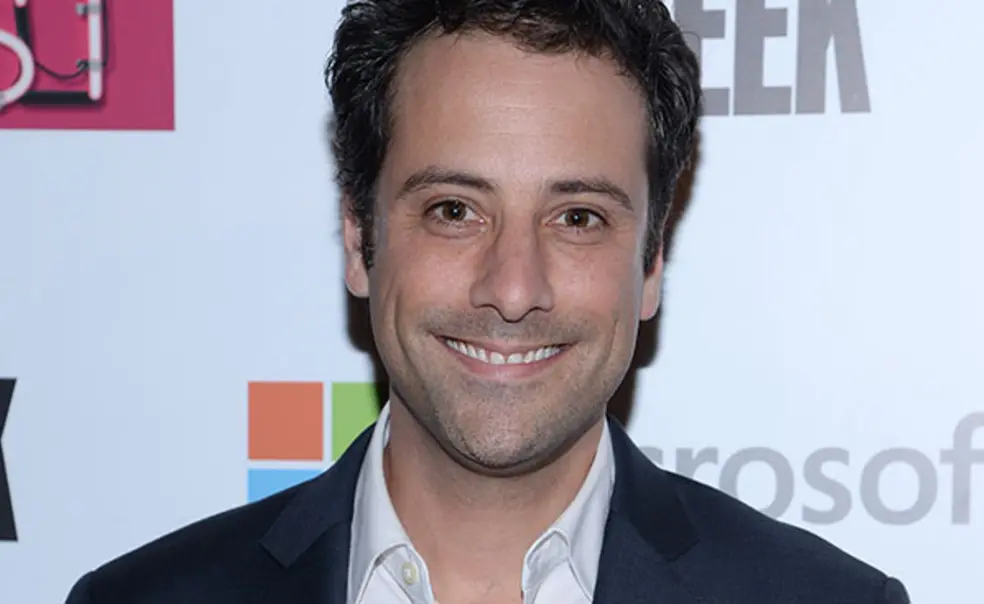Jon Steinberg ’99 Brings Business News to Millennials
When Donald Trump gave his first press conference as president-elect last month, he declined to take questions from veteran reporter Jim Acosta of CNN, describing the network as “fake news.” Instead, Trump called on a man vigorously brandishing a microphone bearing a cartoon lump of yellow cheese and the word “Cheddar” in hot pink letters.
That man, who delivered a sober question on the incoming administration’s economic policies, was Jon Steinberg ’99, founder and CEO of a new video media company with big dreams and a quirky name.
How did Cheddar TV get a coveted seat at the press conference? “Because I’m relentless,” Steinberg says, including a seven-letter modifier that we can’t print. “That’s always the answer.”
For the last 10 months, Steinberg’s startup aimed at millennials has been broadcasting its business news programming over the internet for subscription services such as Sling TV and streaming some of its segments live on Twitter and Facebook. Cheddar already has close to a million viewers each day, according to Steinberg, the former president and COO of BuzzFeed and former CEO of Daily Mail North America.
Still, hearing Steinberg describe Cheddar’s plans to eclipse CNBC’s viewership this year and ultimately replace CNN, one can’t help but relate to the engineers at Disney, who were some of the earliest recipients of Steinberg’s famous intensity.
In 1992, Disney was seeking entrepreneurial computer lovers to join its “Imagineering” research and development arm. Former R&D Director Trevor Bryant devised what he thought was a sure way of uncovering only the most highly qualified applicants. Those interested in the position had to dial in to a relatively obscure bulletin board system and answer a series of increasingly difficult computer programming questions.
Sure enough, Bryant received a letter from a seemingly ideal applicant named Jonathan Steinberg. In the letter, Steinberg described his interest in working for Disney, his computer programming skills, and why he was qualified. The catch: Steinberg was only 15 years old. “That shouldn’t keep you from hiring me,” the teenager wrote at the end of the letter. “We called his parents the next day,” says Bryant, now president and creative director at Virsix, an interactive gaming development company.
Disney hired Steinberg to work as a summer intern analyzing the video game industry. “We gave him a budget and said play these and tell us what you think,” says Bryant. Steinberg immersed himself in the assignment. By the end of the summer, he was presenting his findings to Disney CEO Michael Eisner, who later steered Disney toward investing more in video games.
Three years later, Steinberg took his intensity to the Woodrow Wilson School. He became fascinated with sociology and economics and the idea of bringing a product to market not in a vacuum, but in an environment of human behavior.
After Princeton, Steinberg moved to San Francisco to work with billionaire real estate developer Jerry Speyer. He founded an automated building services company called iBuilding that was “very clearly ahead of its time,” remembers friend and Princeton classmate Ari Weinberg ’99. “It was a cloud-based software as a service for commercial buildings,” says Weinberg.
After the internet bubble burst, Steinberg attended Columbia Business School and eventually became BuzzFeed’s 15th employee, helping redefine the distribution of news and information online through social media. “One of the things that has been a hallmark for Jon is seeing opportunity in platforms,” says Weinberg, a business writer.
With Cheddar, Steinberg is now trying to reinvent traditional TV, which has been steadily losing younger viewers. Millennials still need “ambient linear viewing,” Steinberg believes. That is, as millennials go about their day, they will still need a window on the world that only live programming can provide.
To fund that programming, Cheddar sometimes features corporate sponsors during its segments, with anchors pointedly sipping from Dunkin’ Donuts coffee cups or looking up stocks on Fidelity’s trading app while on air. “One of the things that he’s caught on to is, it’s not TV anymore. You’re not selling 15-, 30-second spots to advertisers that you come back to again,” says Weinberg. “He’s looking to sell six-week, six-month, 1-year relationships where programming is underwritten in advance.”
These native ads, direct subscriptions, and bundles on which Cheddar is available resulted in $2.5 million in revenue last year, says Steinberg, who expects that number to triple or quadruple this year.
Still, the compliment Steinberg enjoys most is when Cheddar viewers tell him they learned something from his broadcasts. “I like informing and educating people,” Steinberg says. If that means waving white and pink Cheddar-branded microphones to get their attention, so be it.












1 Response
Scott Bailey
8 Years AgoI am a regular viewer and...
I am a regular viewer and contributor to #cheddarlive and have been on board now about 7 or 8 months. Being a viewer from Australia, the opening bell (12am AUS. EST) is fun! Also the show has some great stories and some of Americas best Anchors! Internet live streaming will replace the TV within the next 10 - 15 years! Can't wait for more people to catch on to what Jon and the team of #cheddar are creating!